A Critical Analysis of a Qualitative Study on Dementia Decision Making
VerifiedAdded on 2021/06/15
|16
|4990
|124
Report
AI Summary
This report offers a critical analysis of a qualitative study examining decision-making processes for individuals with dementia. The study, conducted in a community setting in London, involved family carers and aimed to identify common and difficult decisions, as well as barriers and facilitators to effective care. The analysis evaluates the study's validity, design, results, and applicability, highlighting the challenges faced by carers in areas such as end-of-life care and the impact of family dynamics. The report also assesses the study's strengths, such as its rigorous data analysis and ethical considerations, while also suggesting areas for future research, such as the role of family conflict. The findings underscore the need for improved support and information for carers, emphasizing the emotional and practical importance of family cohesion and professional assistance in navigating the complexities of dementia care. The report concludes by affirming the study's relevance and applicability to the target population, while also acknowledging the need for further evaluation of interventions aimed at supporting carers.
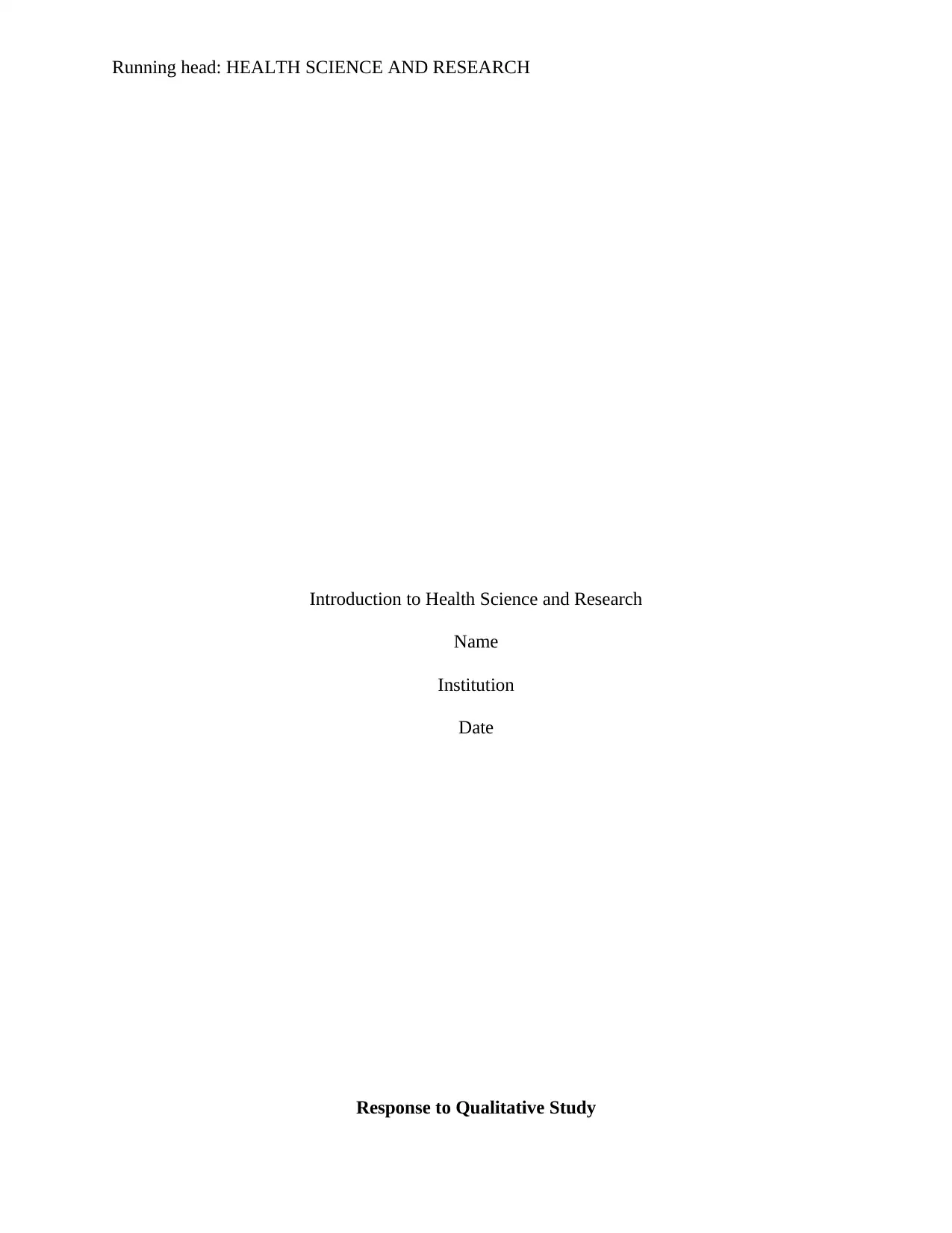
Running head: HEALTH SCIENCE AND RESEARCH
Introduction to Health Science and Research
Name
Institution
Date
Response to Qualitative Study
Introduction to Health Science and Research
Name
Institution
Date
Response to Qualitative Study
Paraphrase This Document
Need a fresh take? Get an instant paraphrase of this document with our AI Paraphraser
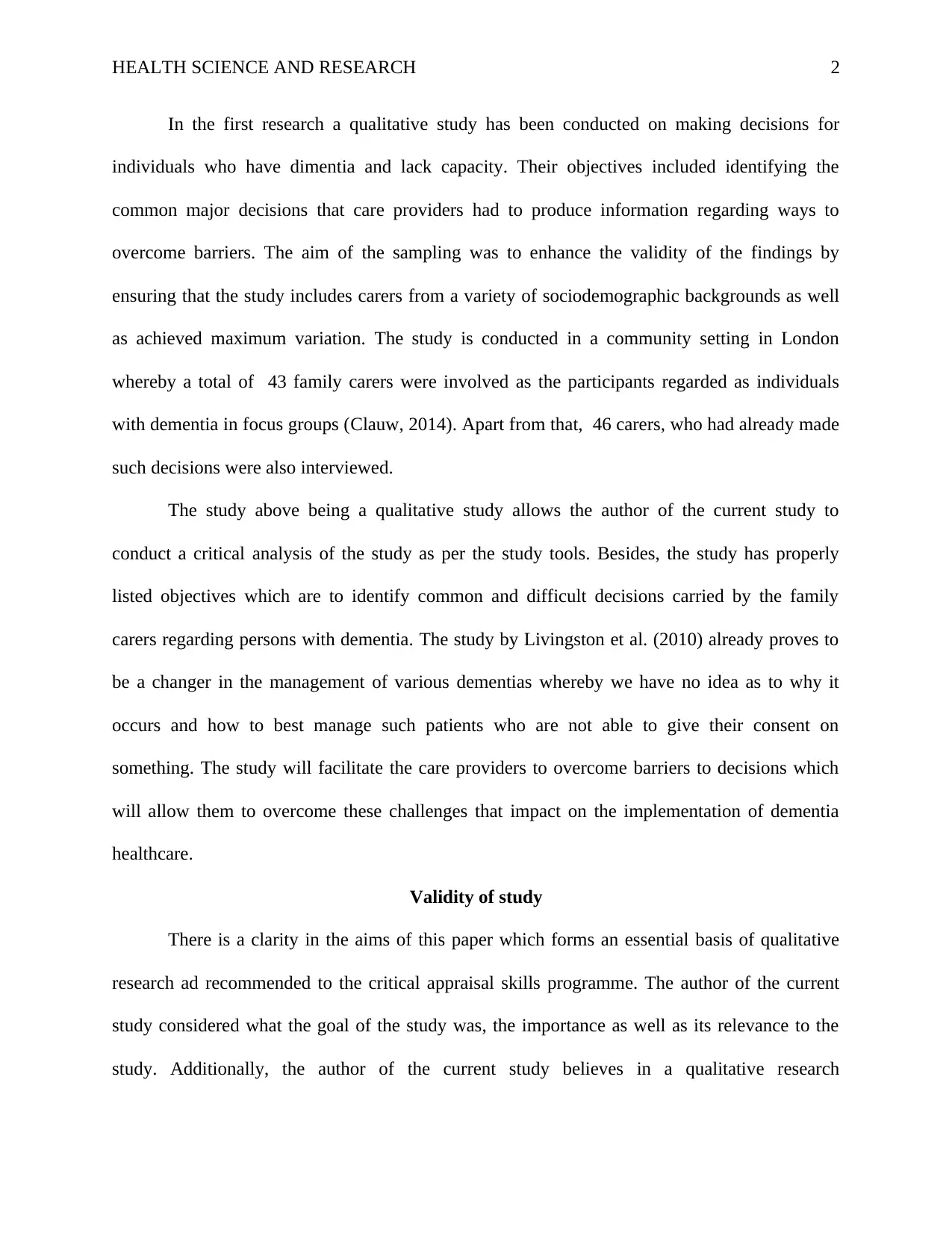
HEALTH SCIENCE AND RESEARCH 2
In the first research a qualitative study has been conducted on making decisions for
individuals who have dimentia and lack capacity. Their objectives included identifying the
common major decisions that care providers had to produce information regarding ways to
overcome barriers. The aim of the sampling was to enhance the validity of the findings by
ensuring that the study includes carers from a variety of sociodemographic backgrounds as well
as achieved maximum variation. The study is conducted in a community setting in London
whereby a total of 43 family carers were involved as the participants regarded as individuals
with dementia in focus groups (Clauw, 2014). Apart from that, 46 carers, who had already made
such decisions were also interviewed.
The study above being a qualitative study allows the author of the current study to
conduct a critical analysis of the study as per the study tools. Besides, the study has properly
listed objectives which are to identify common and difficult decisions carried by the family
carers regarding persons with dementia. The study by Livingston et al. (2010) already proves to
be a changer in the management of various dementias whereby we have no idea as to why it
occurs and how to best manage such patients who are not able to give their consent on
something. The study will facilitate the care providers to overcome barriers to decisions which
will allow them to overcome these challenges that impact on the implementation of dementia
healthcare.
Validity of study
There is a clarity in the aims of this paper which forms an essential basis of qualitative
research ad recommended to the critical appraisal skills programme. The author of the current
study considered what the goal of the study was, the importance as well as its relevance to the
study. Additionally, the author of the current study believes in a qualitative research
In the first research a qualitative study has been conducted on making decisions for
individuals who have dimentia and lack capacity. Their objectives included identifying the
common major decisions that care providers had to produce information regarding ways to
overcome barriers. The aim of the sampling was to enhance the validity of the findings by
ensuring that the study includes carers from a variety of sociodemographic backgrounds as well
as achieved maximum variation. The study is conducted in a community setting in London
whereby a total of 43 family carers were involved as the participants regarded as individuals
with dementia in focus groups (Clauw, 2014). Apart from that, 46 carers, who had already made
such decisions were also interviewed.
The study above being a qualitative study allows the author of the current study to
conduct a critical analysis of the study as per the study tools. Besides, the study has properly
listed objectives which are to identify common and difficult decisions carried by the family
carers regarding persons with dementia. The study by Livingston et al. (2010) already proves to
be a changer in the management of various dementias whereby we have no idea as to why it
occurs and how to best manage such patients who are not able to give their consent on
something. The study will facilitate the care providers to overcome barriers to decisions which
will allow them to overcome these challenges that impact on the implementation of dementia
healthcare.
Validity of study
There is a clarity in the aims of this paper which forms an essential basis of qualitative
research ad recommended to the critical appraisal skills programme. The author of the current
study considered what the goal of the study was, the importance as well as its relevance to the
study. Additionally, the author of the current study believes in a qualitative research
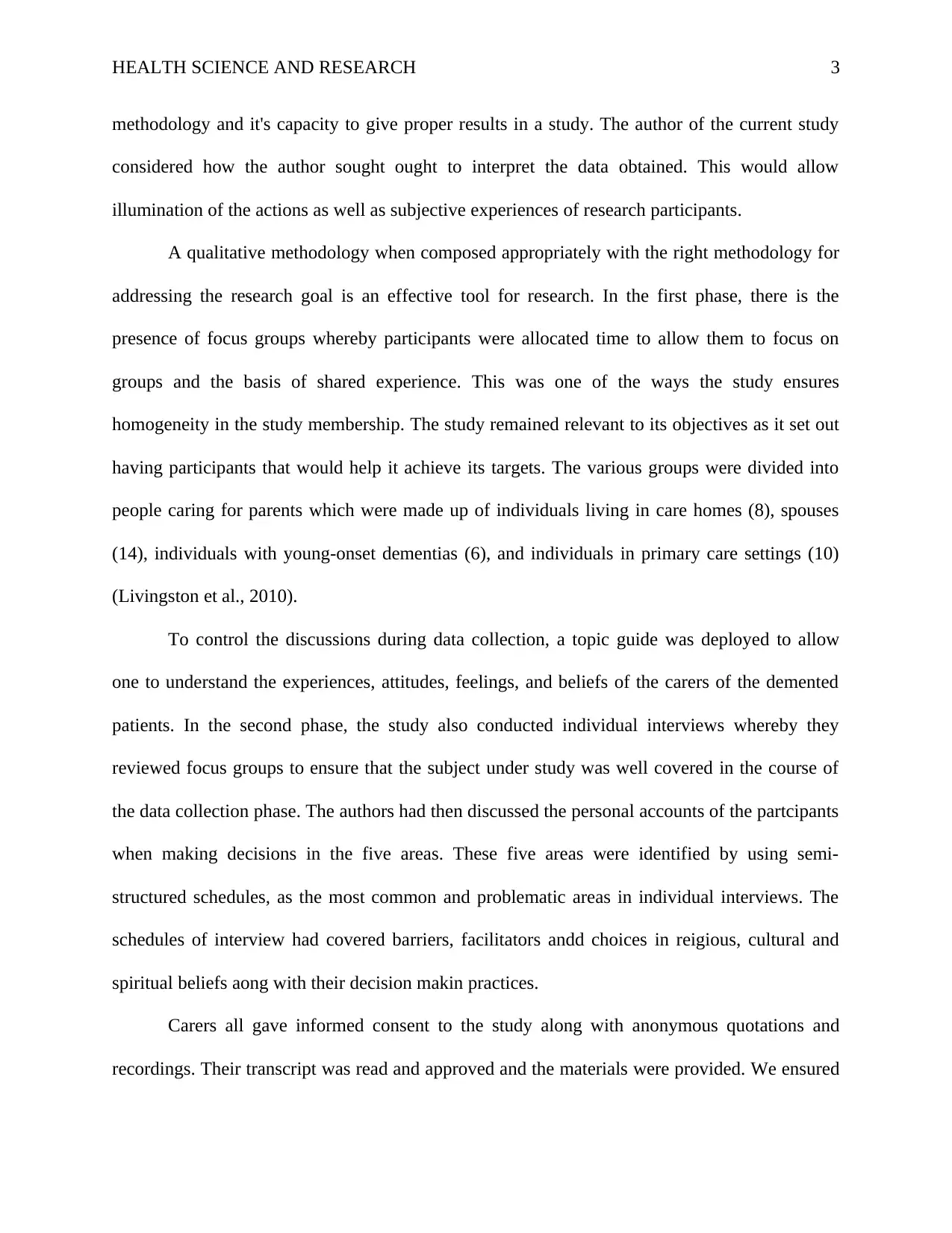
HEALTH SCIENCE AND RESEARCH 3
methodology and it's capacity to give proper results in a study. The author of the current study
considered how the author sought ought to interpret the data obtained. This would allow
illumination of the actions as well as subjective experiences of research participants.
A qualitative methodology when composed appropriately with the right methodology for
addressing the research goal is an effective tool for research. In the first phase, there is the
presence of focus groups whereby participants were allocated time to allow them to focus on
groups and the basis of shared experience. This was one of the ways the study ensures
homogeneity in the study membership. The study remained relevant to its objectives as it set out
having participants that would help it achieve its targets. The various groups were divided into
people caring for parents which were made up of individuals living in care homes (8), spouses
(14), individuals with young-onset dementias (6), and individuals in primary care settings (10)
(Livingston et al., 2010).
To control the discussions during data collection, a topic guide was deployed to allow
one to understand the experiences, attitudes, feelings, and beliefs of the carers of the demented
patients. In the second phase, the study also conducted individual interviews whereby they
reviewed focus groups to ensure that the subject under study was well covered in the course of
the data collection phase. The authors had then discussed the personal accounts of the partcipants
when making decisions in the five areas. These five areas were identified by using semi-
structured schedules, as the most common and problematic areas in individual interviews. The
schedules of interview had covered barriers, facilitators andd choices in reigious, cultural and
spiritual beliefs aong with their decision makin practices.
Carers all gave informed consent to the study along with anonymous quotations and
recordings. Their transcript was read and approved and the materials were provided. We ensured
methodology and it's capacity to give proper results in a study. The author of the current study
considered how the author sought ought to interpret the data obtained. This would allow
illumination of the actions as well as subjective experiences of research participants.
A qualitative methodology when composed appropriately with the right methodology for
addressing the research goal is an effective tool for research. In the first phase, there is the
presence of focus groups whereby participants were allocated time to allow them to focus on
groups and the basis of shared experience. This was one of the ways the study ensures
homogeneity in the study membership. The study remained relevant to its objectives as it set out
having participants that would help it achieve its targets. The various groups were divided into
people caring for parents which were made up of individuals living in care homes (8), spouses
(14), individuals with young-onset dementias (6), and individuals in primary care settings (10)
(Livingston et al., 2010).
To control the discussions during data collection, a topic guide was deployed to allow
one to understand the experiences, attitudes, feelings, and beliefs of the carers of the demented
patients. In the second phase, the study also conducted individual interviews whereby they
reviewed focus groups to ensure that the subject under study was well covered in the course of
the data collection phase. The authors had then discussed the personal accounts of the partcipants
when making decisions in the five areas. These five areas were identified by using semi-
structured schedules, as the most common and problematic areas in individual interviews. The
schedules of interview had covered barriers, facilitators andd choices in reigious, cultural and
spiritual beliefs aong with their decision makin practices.
Carers all gave informed consent to the study along with anonymous quotations and
recordings. Their transcript was read and approved and the materials were provided. We ensured
⊘ This is a preview!⊘
Do you want full access?
Subscribe today to unlock all pages.

Trusted by 1+ million students worldwide
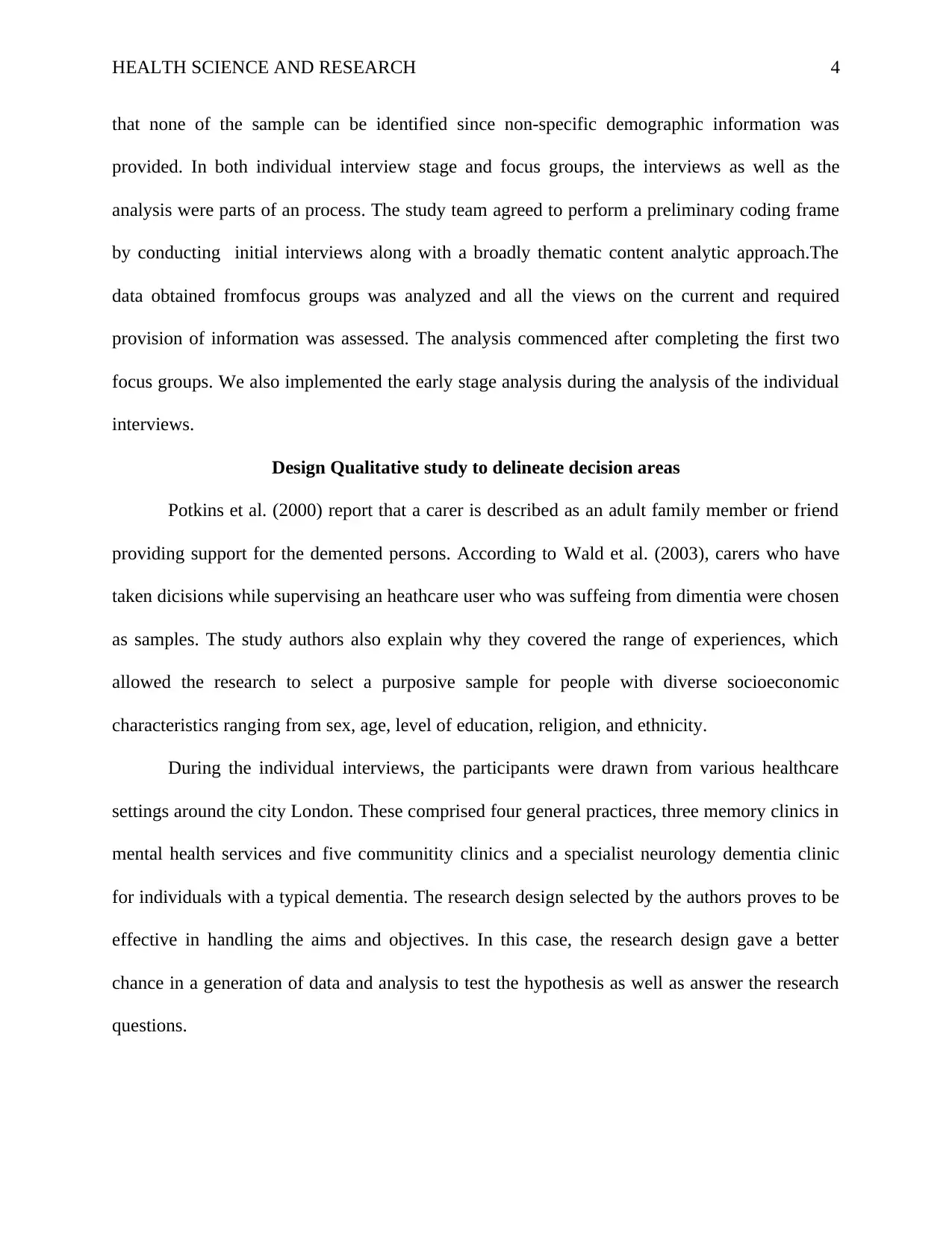
HEALTH SCIENCE AND RESEARCH 4
that none of the sample can be identified since non-specific demographic information was
provided. In both individual interview stage and focus groups, the interviews as well as the
analysis were parts of an process. The study team agreed to perform a preliminary coding frame
by conducting initial interviews along with a broadly thematic content analytic approach.The
data obtained fromfocus groups was analyzed and all the views on the current and required
provision of information was assessed. The analysis commenced after completing the first two
focus groups. We also implemented the early stage analysis during the analysis of the individual
interviews.
Design Qualitative study to delineate decision areas
Potkins et al. (2000) report that a carer is described as an adult family member or friend
providing support for the demented persons. According to Wald et al. (2003), carers who have
taken dicisions while supervising an heathcare user who was suffeing from dimentia were chosen
as samples. The study authors also explain why they covered the range of experiences, which
allowed the research to select a purposive sample for people with diverse socioeconomic
characteristics ranging from sex, age, level of education, religion, and ethnicity.
During the individual interviews, the participants were drawn from various healthcare
settings around the city London. These comprised four general practices, three memory clinics in
mental health services and five communitity clinics and a specialist neurology dementia clinic
for individuals with a typical dementia. The research design selected by the authors proves to be
effective in handling the aims and objectives. In this case, the research design gave a better
chance in a generation of data and analysis to test the hypothesis as well as answer the research
questions.
that none of the sample can be identified since non-specific demographic information was
provided. In both individual interview stage and focus groups, the interviews as well as the
analysis were parts of an process. The study team agreed to perform a preliminary coding frame
by conducting initial interviews along with a broadly thematic content analytic approach.The
data obtained fromfocus groups was analyzed and all the views on the current and required
provision of information was assessed. The analysis commenced after completing the first two
focus groups. We also implemented the early stage analysis during the analysis of the individual
interviews.
Design Qualitative study to delineate decision areas
Potkins et al. (2000) report that a carer is described as an adult family member or friend
providing support for the demented persons. According to Wald et al. (2003), carers who have
taken dicisions while supervising an heathcare user who was suffeing from dimentia were chosen
as samples. The study authors also explain why they covered the range of experiences, which
allowed the research to select a purposive sample for people with diverse socioeconomic
characteristics ranging from sex, age, level of education, religion, and ethnicity.
During the individual interviews, the participants were drawn from various healthcare
settings around the city London. These comprised four general practices, three memory clinics in
mental health services and five communitity clinics and a specialist neurology dementia clinic
for individuals with a typical dementia. The research design selected by the authors proves to be
effective in handling the aims and objectives. In this case, the research design gave a better
chance in a generation of data and analysis to test the hypothesis as well as answer the research
questions.
Paraphrase This Document
Need a fresh take? Get an instant paraphrase of this document with our AI Paraphraser
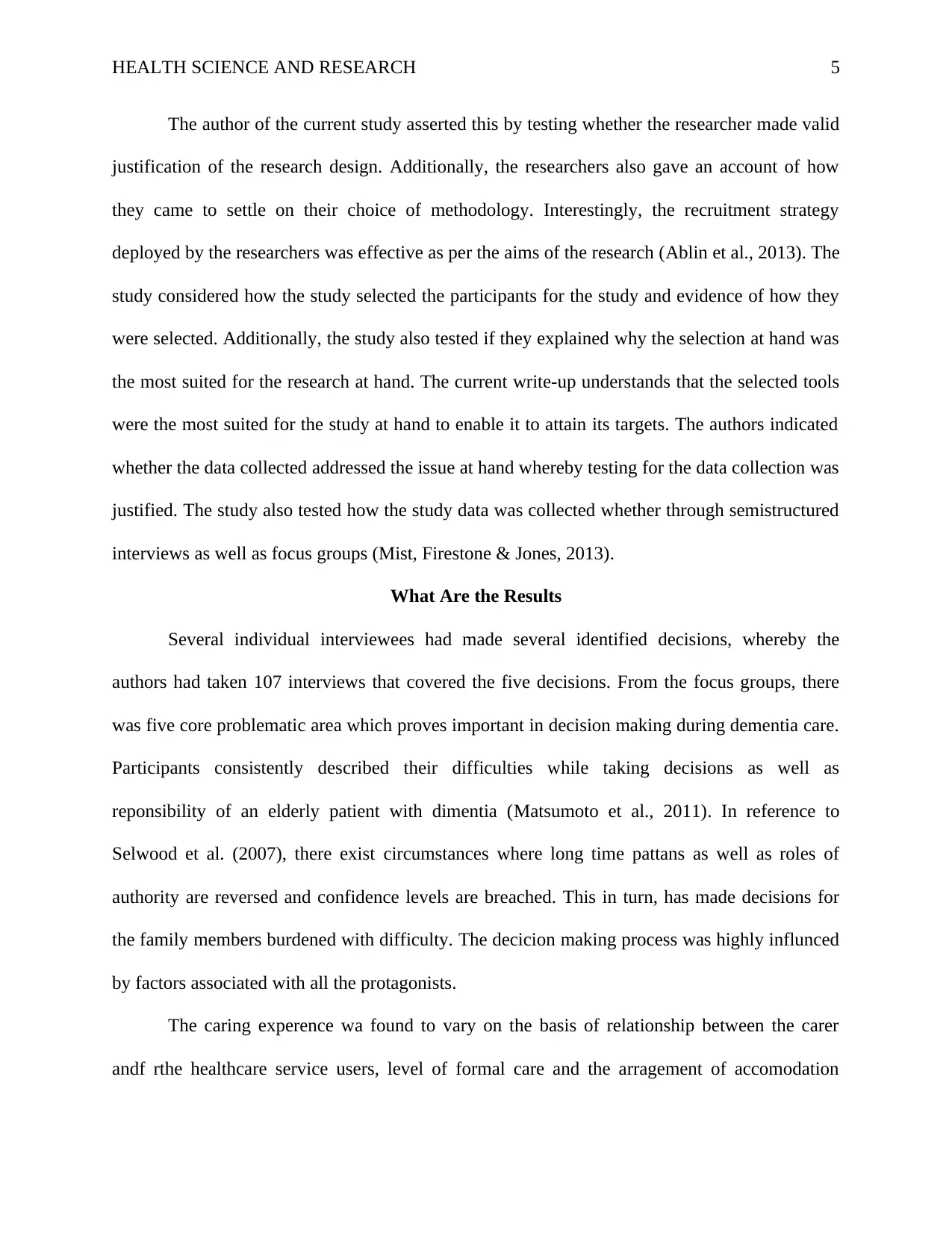
HEALTH SCIENCE AND RESEARCH 5
The author of the current study asserted this by testing whether the researcher made valid
justification of the research design. Additionally, the researchers also gave an account of how
they came to settle on their choice of methodology. Interestingly, the recruitment strategy
deployed by the researchers was effective as per the aims of the research (Ablin et al., 2013). The
study considered how the study selected the participants for the study and evidence of how they
were selected. Additionally, the study also tested if they explained why the selection at hand was
the most suited for the research at hand. The current write-up understands that the selected tools
were the most suited for the study at hand to enable it to attain its targets. The authors indicated
whether the data collected addressed the issue at hand whereby testing for the data collection was
justified. The study also tested how the study data was collected whether through semistructured
interviews as well as focus groups (Mist, Firestone & Jones, 2013).
What Are the Results
Several individual interviewees had made several identified decisions, whereby the
authors had taken 107 interviews that covered the five decisions. From the focus groups, there
was five core problematic area which proves important in decision making during dementia care.
Participants consistently described their difficulties while taking decisions as well as
reponsibility of an elderly patient with dimentia (Matsumoto et al., 2011). In reference to
Selwood et al. (2007), there exist circumstances where long time pattans as well as roles of
authority are reversed and confidence levels are breached. This in turn, has made decisions for
the family members burdened with difficulty. The decicion making process was highly influnced
by factors associated with all the protagonists.
The caring experence wa found to vary on the basis of relationship between the carer
andf rthe healthcare service users, level of formal care and the arragement of accomodation
The author of the current study asserted this by testing whether the researcher made valid
justification of the research design. Additionally, the researchers also gave an account of how
they came to settle on their choice of methodology. Interestingly, the recruitment strategy
deployed by the researchers was effective as per the aims of the research (Ablin et al., 2013). The
study considered how the study selected the participants for the study and evidence of how they
were selected. Additionally, the study also tested if they explained why the selection at hand was
the most suited for the research at hand. The current write-up understands that the selected tools
were the most suited for the study at hand to enable it to attain its targets. The authors indicated
whether the data collected addressed the issue at hand whereby testing for the data collection was
justified. The study also tested how the study data was collected whether through semistructured
interviews as well as focus groups (Mist, Firestone & Jones, 2013).
What Are the Results
Several individual interviewees had made several identified decisions, whereby the
authors had taken 107 interviews that covered the five decisions. From the focus groups, there
was five core problematic area which proves important in decision making during dementia care.
Participants consistently described their difficulties while taking decisions as well as
reponsibility of an elderly patient with dimentia (Matsumoto et al., 2011). In reference to
Selwood et al. (2007), there exist circumstances where long time pattans as well as roles of
authority are reversed and confidence levels are breached. This in turn, has made decisions for
the family members burdened with difficulty. The decicion making process was highly influnced
by factors associated with all the protagonists.
The caring experence wa found to vary on the basis of relationship between the carer
andf rthe healthcare service users, level of formal care and the arragement of accomodation
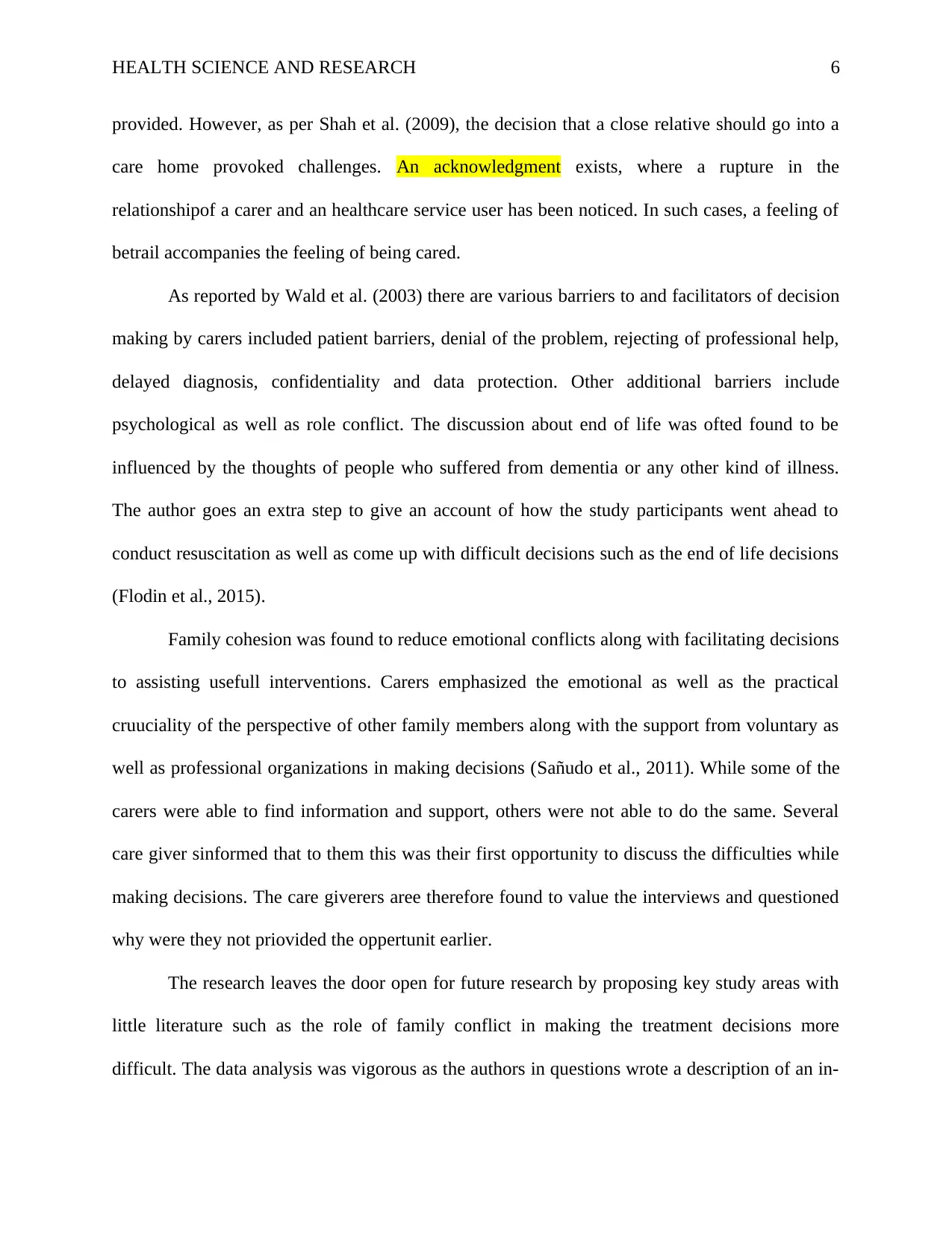
HEALTH SCIENCE AND RESEARCH 6
provided. However, as per Shah et al. (2009), the decision that a close relative should go into a
care home provoked challenges. An acknowledgment exists, where a rupture in the
relationshipof a carer and an healthcare service user has been noticed. In such cases, a feeling of
betrail accompanies the feeling of being cared.
As reported by Wald et al. (2003) there are various barriers to and facilitators of decision
making by carers included patient barriers, denial of the problem, rejecting of professional help,
delayed diagnosis, confidentiality and data protection. Other additional barriers include
psychological as well as role conflict. The discussion about end of life was ofted found to be
influenced by the thoughts of people who suffered from dementia or any other kind of illness.
The author goes an extra step to give an account of how the study participants went ahead to
conduct resuscitation as well as come up with difficult decisions such as the end of life decisions
(Flodin et al., 2015).
Family cohesion was found to reduce emotional conflicts along with facilitating decisions
to assisting usefull interventions. Carers emphasized the emotional as well as the practical
cruuciality of the perspective of other family members along with the support from voluntary as
well as professional organizations in making decisions (Sañudo et al., 2011). While some of the
carers were able to find information and support, others were not able to do the same. Several
care giver sinformed that to them this was their first opportunity to discuss the difficulties while
making decisions. The care giverers aree therefore found to value the interviews and questioned
why were they not priovided the oppertunit earlier.
The research leaves the door open for future research by proposing key study areas with
little literature such as the role of family conflict in making the treatment decisions more
difficult. The data analysis was vigorous as the authors in questions wrote a description of an in-
provided. However, as per Shah et al. (2009), the decision that a close relative should go into a
care home provoked challenges. An acknowledgment exists, where a rupture in the
relationshipof a carer and an healthcare service user has been noticed. In such cases, a feeling of
betrail accompanies the feeling of being cared.
As reported by Wald et al. (2003) there are various barriers to and facilitators of decision
making by carers included patient barriers, denial of the problem, rejecting of professional help,
delayed diagnosis, confidentiality and data protection. Other additional barriers include
psychological as well as role conflict. The discussion about end of life was ofted found to be
influenced by the thoughts of people who suffered from dementia or any other kind of illness.
The author goes an extra step to give an account of how the study participants went ahead to
conduct resuscitation as well as come up with difficult decisions such as the end of life decisions
(Flodin et al., 2015).
Family cohesion was found to reduce emotional conflicts along with facilitating decisions
to assisting usefull interventions. Carers emphasized the emotional as well as the practical
cruuciality of the perspective of other family members along with the support from voluntary as
well as professional organizations in making decisions (Sañudo et al., 2011). While some of the
carers were able to find information and support, others were not able to do the same. Several
care giver sinformed that to them this was their first opportunity to discuss the difficulties while
making decisions. The care giverers aree therefore found to value the interviews and questioned
why were they not priovided the oppertunit earlier.
The research leaves the door open for future research by proposing key study areas with
little literature such as the role of family conflict in making the treatment decisions more
difficult. The data analysis was vigorous as the authors in questions wrote a description of an in-
⊘ This is a preview!⊘
Do you want full access?
Subscribe today to unlock all pages.

Trusted by 1+ million students worldwide
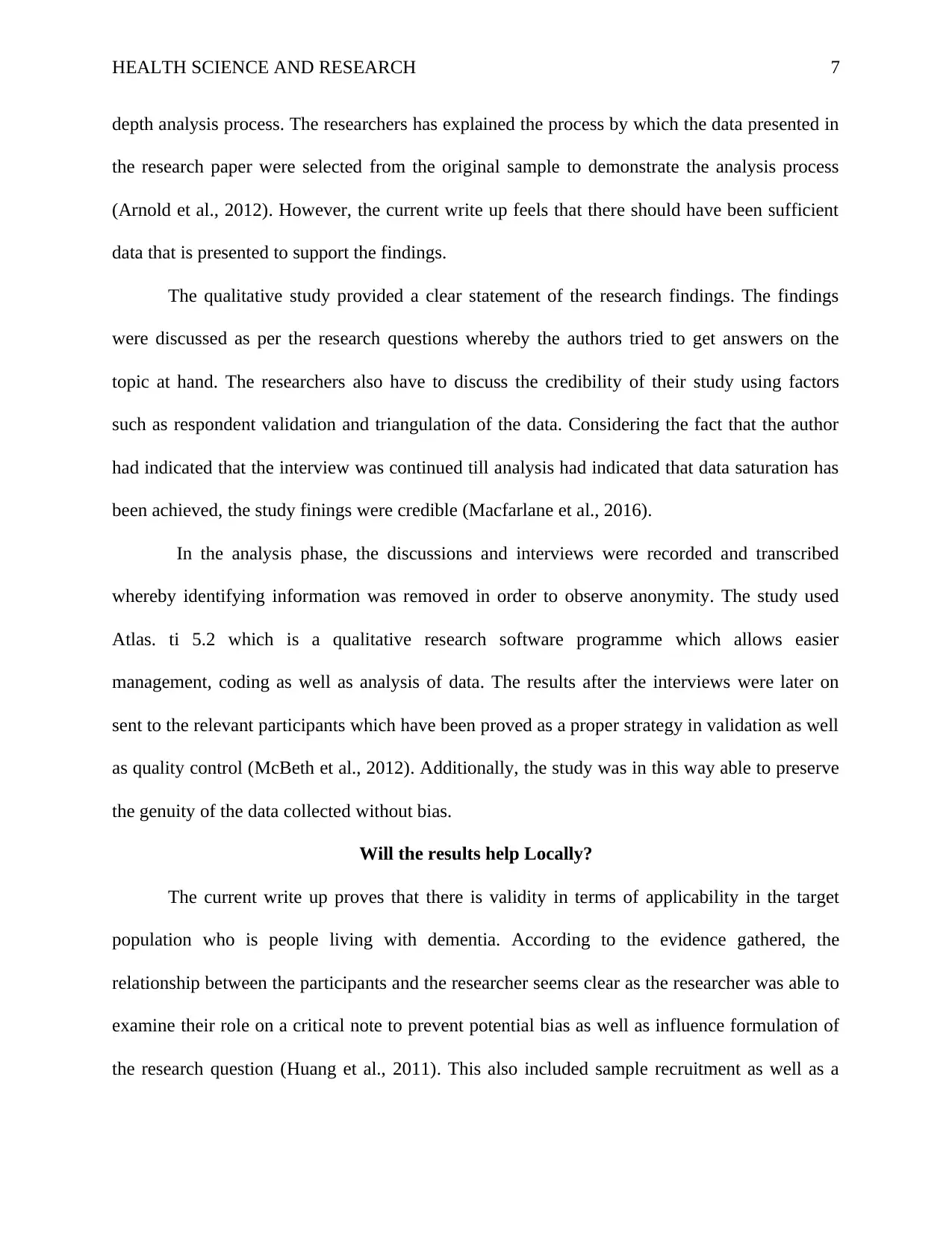
HEALTH SCIENCE AND RESEARCH 7
depth analysis process. The researchers has explained the process by which the data presented in
the research paper were selected from the original sample to demonstrate the analysis process
(Arnold et al., 2012). However, the current write up feels that there should have been sufficient
data that is presented to support the findings.
The qualitative study provided a clear statement of the research findings. The findings
were discussed as per the research questions whereby the authors tried to get answers on the
topic at hand. The researchers also have to discuss the credibility of their study using factors
such as respondent validation and triangulation of the data. Considering the fact that the author
had indicated that the interview was continued till analysis had indicated that data saturation has
been achieved, the study finings were credible (Macfarlane et al., 2016).
In the analysis phase, the discussions and interviews were recorded and transcribed
whereby identifying information was removed in order to observe anonymity. The study used
Atlas. ti 5.2 which is a qualitative research software programme which allows easier
management, coding as well as analysis of data. The results after the interviews were later on
sent to the relevant participants which have been proved as a proper strategy in validation as well
as quality control (McBeth et al., 2012). Additionally, the study was in this way able to preserve
the genuity of the data collected without bias.
Will the results help Locally?
The current write up proves that there is validity in terms of applicability in the target
population who is people living with dementia. According to the evidence gathered, the
relationship between the participants and the researcher seems clear as the researcher was able to
examine their role on a critical note to prevent potential bias as well as influence formulation of
the research question (Huang et al., 2011). This also included sample recruitment as well as a
depth analysis process. The researchers has explained the process by which the data presented in
the research paper were selected from the original sample to demonstrate the analysis process
(Arnold et al., 2012). However, the current write up feels that there should have been sufficient
data that is presented to support the findings.
The qualitative study provided a clear statement of the research findings. The findings
were discussed as per the research questions whereby the authors tried to get answers on the
topic at hand. The researchers also have to discuss the credibility of their study using factors
such as respondent validation and triangulation of the data. Considering the fact that the author
had indicated that the interview was continued till analysis had indicated that data saturation has
been achieved, the study finings were credible (Macfarlane et al., 2016).
In the analysis phase, the discussions and interviews were recorded and transcribed
whereby identifying information was removed in order to observe anonymity. The study used
Atlas. ti 5.2 which is a qualitative research software programme which allows easier
management, coding as well as analysis of data. The results after the interviews were later on
sent to the relevant participants which have been proved as a proper strategy in validation as well
as quality control (McBeth et al., 2012). Additionally, the study was in this way able to preserve
the genuity of the data collected without bias.
Will the results help Locally?
The current write up proves that there is validity in terms of applicability in the target
population who is people living with dementia. According to the evidence gathered, the
relationship between the participants and the researcher seems clear as the researcher was able to
examine their role on a critical note to prevent potential bias as well as influence formulation of
the research question (Huang et al., 2011). This also included sample recruitment as well as a
Paraphrase This Document
Need a fresh take? Get an instant paraphrase of this document with our AI Paraphraser
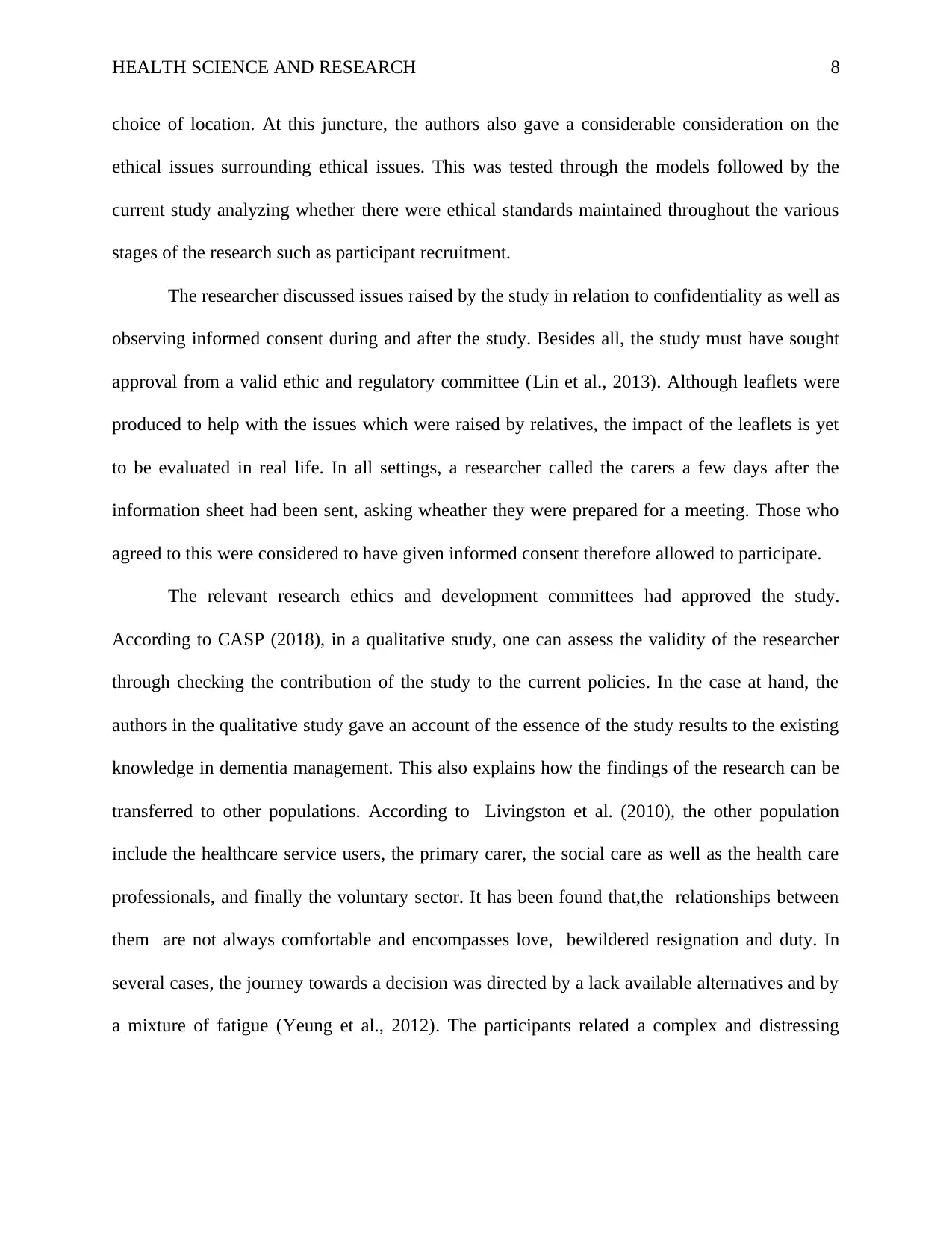
HEALTH SCIENCE AND RESEARCH 8
choice of location. At this juncture, the authors also gave a considerable consideration on the
ethical issues surrounding ethical issues. This was tested through the models followed by the
current study analyzing whether there were ethical standards maintained throughout the various
stages of the research such as participant recruitment.
The researcher discussed issues raised by the study in relation to confidentiality as well as
observing informed consent during and after the study. Besides all, the study must have sought
approval from a valid ethic and regulatory committee (Lin et al., 2013). Although leaflets were
produced to help with the issues which were raised by relatives, the impact of the leaflets is yet
to be evaluated in real life. In all settings, a researcher called the carers a few days after the
information sheet had been sent, asking wheather they were prepared for a meeting. Those who
agreed to this were considered to have given informed consent therefore allowed to participate.
The relevant research ethics and development committees had approved the study.
According to CASP (2018), in a qualitative study, one can assess the validity of the researcher
through checking the contribution of the study to the current policies. In the case at hand, the
authors in the qualitative study gave an account of the essence of the study results to the existing
knowledge in dementia management. This also explains how the findings of the research can be
transferred to other populations. According to Livingston et al. (2010), the other population
include the healthcare service users, the primary carer, the social care as well as the health care
professionals, and finally the voluntary sector. It has been found that,the relationships between
them are not always comfortable and encompasses love, bewildered resignation and duty. In
several cases, the journey towards a decision was directed by a lack available alternatives and by
a mixture of fatigue (Yeung et al., 2012). The participants related a complex and distressing
choice of location. At this juncture, the authors also gave a considerable consideration on the
ethical issues surrounding ethical issues. This was tested through the models followed by the
current study analyzing whether there were ethical standards maintained throughout the various
stages of the research such as participant recruitment.
The researcher discussed issues raised by the study in relation to confidentiality as well as
observing informed consent during and after the study. Besides all, the study must have sought
approval from a valid ethic and regulatory committee (Lin et al., 2013). Although leaflets were
produced to help with the issues which were raised by relatives, the impact of the leaflets is yet
to be evaluated in real life. In all settings, a researcher called the carers a few days after the
information sheet had been sent, asking wheather they were prepared for a meeting. Those who
agreed to this were considered to have given informed consent therefore allowed to participate.
The relevant research ethics and development committees had approved the study.
According to CASP (2018), in a qualitative study, one can assess the validity of the researcher
through checking the contribution of the study to the current policies. In the case at hand, the
authors in the qualitative study gave an account of the essence of the study results to the existing
knowledge in dementia management. This also explains how the findings of the research can be
transferred to other populations. According to Livingston et al. (2010), the other population
include the healthcare service users, the primary carer, the social care as well as the health care
professionals, and finally the voluntary sector. It has been found that,the relationships between
them are not always comfortable and encompasses love, bewildered resignation and duty. In
several cases, the journey towards a decision was directed by a lack available alternatives and by
a mixture of fatigue (Yeung et al., 2012). The participants related a complex and distressing
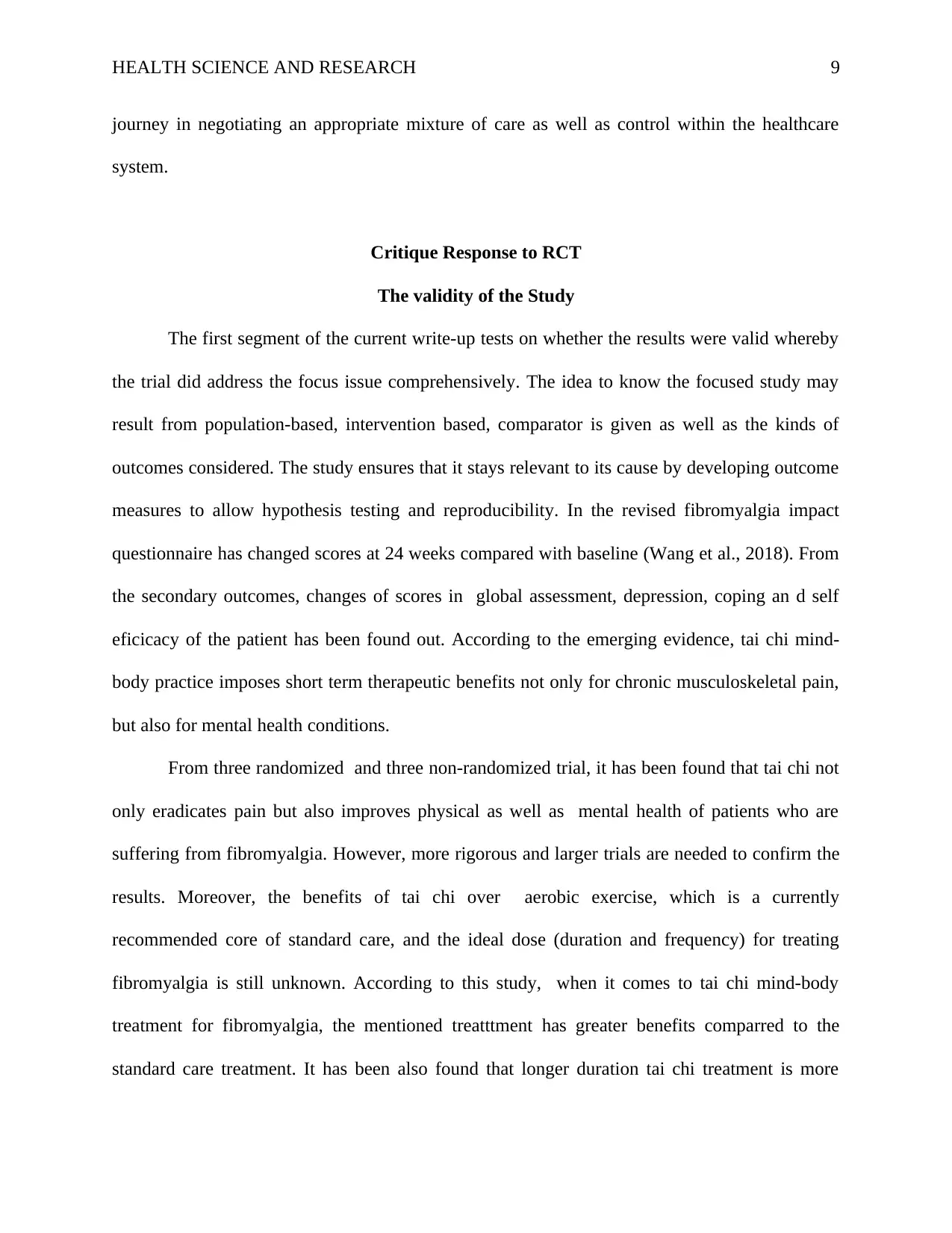
HEALTH SCIENCE AND RESEARCH 9
journey in negotiating an appropriate mixture of care as well as control within the healthcare
system.
Critique Response to RCT
The validity of the Study
The first segment of the current write-up tests on whether the results were valid whereby
the trial did address the focus issue comprehensively. The idea to know the focused study may
result from population-based, intervention based, comparator is given as well as the kinds of
outcomes considered. The study ensures that it stays relevant to its cause by developing outcome
measures to allow hypothesis testing and reproducibility. In the revised fibromyalgia impact
questionnaire has changed scores at 24 weeks compared with baseline (Wang et al., 2018). From
the secondary outcomes, changes of scores in global assessment, depression, coping an d self
eficicacy of the patient has been found out. According to the emerging evidence, tai chi mind-
body practice imposes short term therapeutic benefits not only for chronic musculoskeletal pain,
but also for mental health conditions.
From three randomized and three non-randomized trial, it has been found that tai chi not
only eradicates pain but also improves physical as well as mental health of patients who are
suffering from fibromyalgia. However, more rigorous and larger trials are needed to confirm the
results. Moreover, the benefits of tai chi over aerobic exercise, which is a currently
recommended core of standard care, and the ideal dose (duration and frequency) for treating
fibromyalgia is still unknown. According to this study, when it comes to tai chi mind-body
treatment for fibromyalgia, the mentioned treatttment has greater benefits comparred to the
standard care treatment. It has been also found that longer duration tai chi treatment is more
journey in negotiating an appropriate mixture of care as well as control within the healthcare
system.
Critique Response to RCT
The validity of the Study
The first segment of the current write-up tests on whether the results were valid whereby
the trial did address the focus issue comprehensively. The idea to know the focused study may
result from population-based, intervention based, comparator is given as well as the kinds of
outcomes considered. The study ensures that it stays relevant to its cause by developing outcome
measures to allow hypothesis testing and reproducibility. In the revised fibromyalgia impact
questionnaire has changed scores at 24 weeks compared with baseline (Wang et al., 2018). From
the secondary outcomes, changes of scores in global assessment, depression, coping an d self
eficicacy of the patient has been found out. According to the emerging evidence, tai chi mind-
body practice imposes short term therapeutic benefits not only for chronic musculoskeletal pain,
but also for mental health conditions.
From three randomized and three non-randomized trial, it has been found that tai chi not
only eradicates pain but also improves physical as well as mental health of patients who are
suffering from fibromyalgia. However, more rigorous and larger trials are needed to confirm the
results. Moreover, the benefits of tai chi over aerobic exercise, which is a currently
recommended core of standard care, and the ideal dose (duration and frequency) for treating
fibromyalgia is still unknown. According to this study, when it comes to tai chi mind-body
treatment for fibromyalgia, the mentioned treatttment has greater benefits comparred to the
standard care treatment. It has been also found that longer duration tai chi treatment is more
⊘ This is a preview!⊘
Do you want full access?
Subscribe today to unlock all pages.

Trusted by 1+ million students worldwide
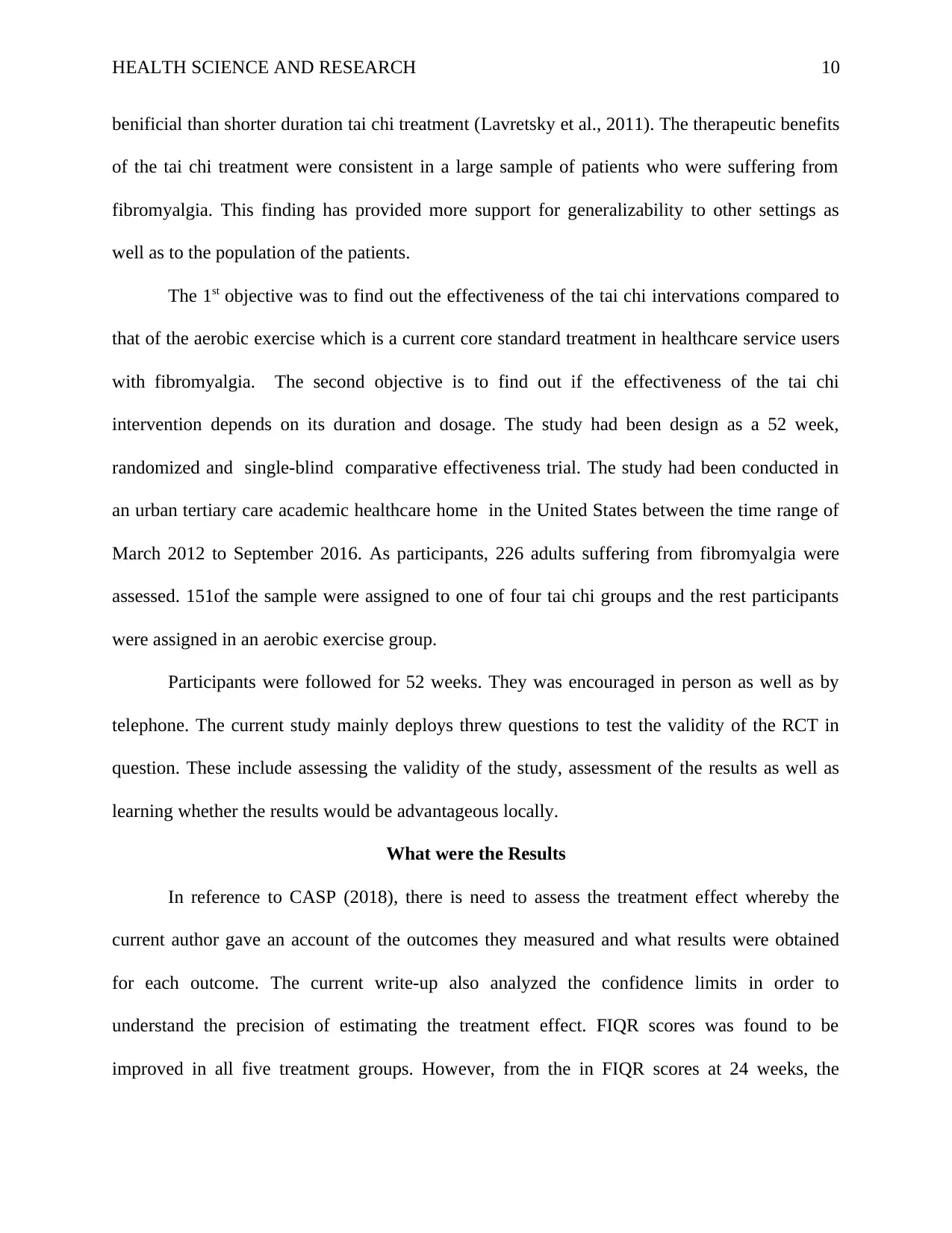
HEALTH SCIENCE AND RESEARCH 10
benificial than shorter duration tai chi treatment (Lavretsky et al., 2011). The therapeutic benefits
of the tai chi treatment were consistent in a large sample of patients who were suffering from
fibromyalgia. This finding has provided more support for generalizability to other settings as
well as to the population of the patients.
The 1st objective was to find out the effectiveness of the tai chi intervations compared to
that of the aerobic exercise which is a current core standard treatment in healthcare service users
with fibromyalgia. The second objective is to find out if the effectiveness of the tai chi
intervention depends on its duration and dosage. The study had been design as a 52 week,
randomized and single-blind comparative effectiveness trial. The study had been conducted in
an urban tertiary care academic healthcare home in the United States between the time range of
March 2012 to September 2016. As participants, 226 adults suffering from fibromyalgia were
assessed. 151of the sample were assigned to one of four tai chi groups and the rest participants
were assigned in an aerobic exercise group.
Participants were followed for 52 weeks. They was encouraged in person as well as by
telephone. The current study mainly deploys threw questions to test the validity of the RCT in
question. These include assessing the validity of the study, assessment of the results as well as
learning whether the results would be advantageous locally.
What were the Results
In reference to CASP (2018), there is need to assess the treatment effect whereby the
current author gave an account of the outcomes they measured and what results were obtained
for each outcome. The current write-up also analyzed the confidence limits in order to
understand the precision of estimating the treatment effect. FIQR scores was found to be
improved in all five treatment groups. However, from the in FIQR scores at 24 weeks, the
benificial than shorter duration tai chi treatment (Lavretsky et al., 2011). The therapeutic benefits
of the tai chi treatment were consistent in a large sample of patients who were suffering from
fibromyalgia. This finding has provided more support for generalizability to other settings as
well as to the population of the patients.
The 1st objective was to find out the effectiveness of the tai chi intervations compared to
that of the aerobic exercise which is a current core standard treatment in healthcare service users
with fibromyalgia. The second objective is to find out if the effectiveness of the tai chi
intervention depends on its duration and dosage. The study had been design as a 52 week,
randomized and single-blind comparative effectiveness trial. The study had been conducted in
an urban tertiary care academic healthcare home in the United States between the time range of
March 2012 to September 2016. As participants, 226 adults suffering from fibromyalgia were
assessed. 151of the sample were assigned to one of four tai chi groups and the rest participants
were assigned in an aerobic exercise group.
Participants were followed for 52 weeks. They was encouraged in person as well as by
telephone. The current study mainly deploys threw questions to test the validity of the RCT in
question. These include assessing the validity of the study, assessment of the results as well as
learning whether the results would be advantageous locally.
What were the Results
In reference to CASP (2018), there is need to assess the treatment effect whereby the
current author gave an account of the outcomes they measured and what results were obtained
for each outcome. The current write-up also analyzed the confidence limits in order to
understand the precision of estimating the treatment effect. FIQR scores was found to be
improved in all five treatment groups. However, from the in FIQR scores at 24 weeks, the
Paraphrase This Document
Need a fresh take? Get an instant paraphrase of this document with our AI Paraphraser
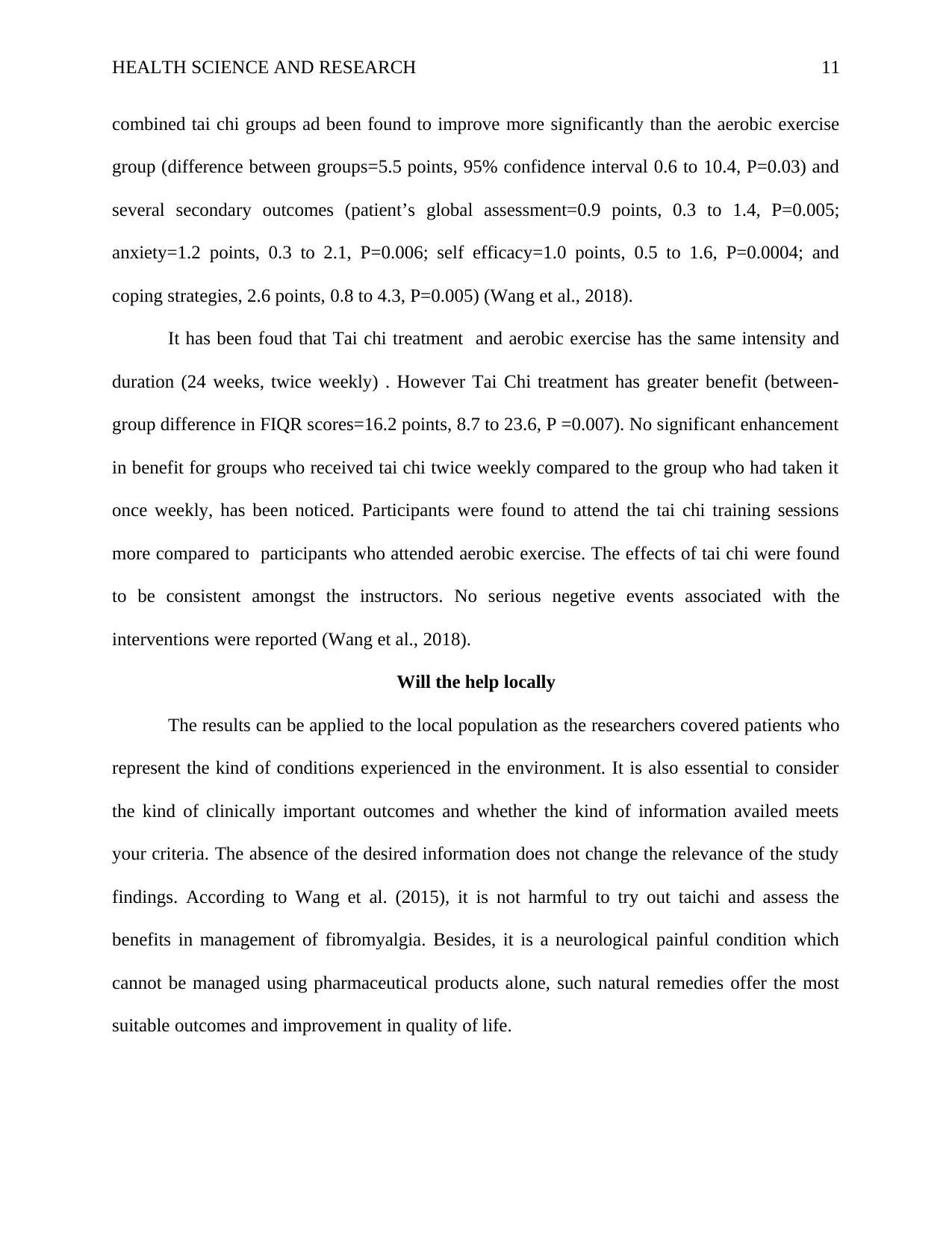
HEALTH SCIENCE AND RESEARCH 11
combined tai chi groups ad been found to improve more significantly than the aerobic exercise
group (difference between groups=5.5 points, 95% confidence interval 0.6 to 10.4, P=0.03) and
several secondary outcomes (patient’s global assessment=0.9 points, 0.3 to 1.4, P=0.005;
anxiety=1.2 points, 0.3 to 2.1, P=0.006; self efficacy=1.0 points, 0.5 to 1.6, P=0.0004; and
coping strategies, 2.6 points, 0.8 to 4.3, P=0.005) (Wang et al., 2018).
It has been foud that Tai chi treatment and aerobic exercise has the same intensity and
duration (24 weeks, twice weekly) . However Tai Chi treatment has greater benefit (between-
group difference in FIQR scores=16.2 points, 8.7 to 23.6, P =0.007). No significant enhancement
in benefit for groups who received tai chi twice weekly compared to the group who had taken it
once weekly, has been noticed. Participants were found to attend the tai chi training sessions
more compared to participants who attended aerobic exercise. The effects of tai chi were found
to be consistent amongst the instructors. No serious negetive events associated with the
interventions were reported (Wang et al., 2018).
Will the help locally
The results can be applied to the local population as the researchers covered patients who
represent the kind of conditions experienced in the environment. It is also essential to consider
the kind of clinically important outcomes and whether the kind of information availed meets
your criteria. The absence of the desired information does not change the relevance of the study
findings. According to Wang et al. (2015), it is not harmful to try out taichi and assess the
benefits in management of fibromyalgia. Besides, it is a neurological painful condition which
cannot be managed using pharmaceutical products alone, such natural remedies offer the most
suitable outcomes and improvement in quality of life.
combined tai chi groups ad been found to improve more significantly than the aerobic exercise
group (difference between groups=5.5 points, 95% confidence interval 0.6 to 10.4, P=0.03) and
several secondary outcomes (patient’s global assessment=0.9 points, 0.3 to 1.4, P=0.005;
anxiety=1.2 points, 0.3 to 2.1, P=0.006; self efficacy=1.0 points, 0.5 to 1.6, P=0.0004; and
coping strategies, 2.6 points, 0.8 to 4.3, P=0.005) (Wang et al., 2018).
It has been foud that Tai chi treatment and aerobic exercise has the same intensity and
duration (24 weeks, twice weekly) . However Tai Chi treatment has greater benefit (between-
group difference in FIQR scores=16.2 points, 8.7 to 23.6, P =0.007). No significant enhancement
in benefit for groups who received tai chi twice weekly compared to the group who had taken it
once weekly, has been noticed. Participants were found to attend the tai chi training sessions
more compared to participants who attended aerobic exercise. The effects of tai chi were found
to be consistent amongst the instructors. No serious negetive events associated with the
interventions were reported (Wang et al., 2018).
Will the help locally
The results can be applied to the local population as the researchers covered patients who
represent the kind of conditions experienced in the environment. It is also essential to consider
the kind of clinically important outcomes and whether the kind of information availed meets
your criteria. The absence of the desired information does not change the relevance of the study
findings. According to Wang et al. (2015), it is not harmful to try out taichi and assess the
benefits in management of fibromyalgia. Besides, it is a neurological painful condition which
cannot be managed using pharmaceutical products alone, such natural remedies offer the most
suitable outcomes and improvement in quality of life.
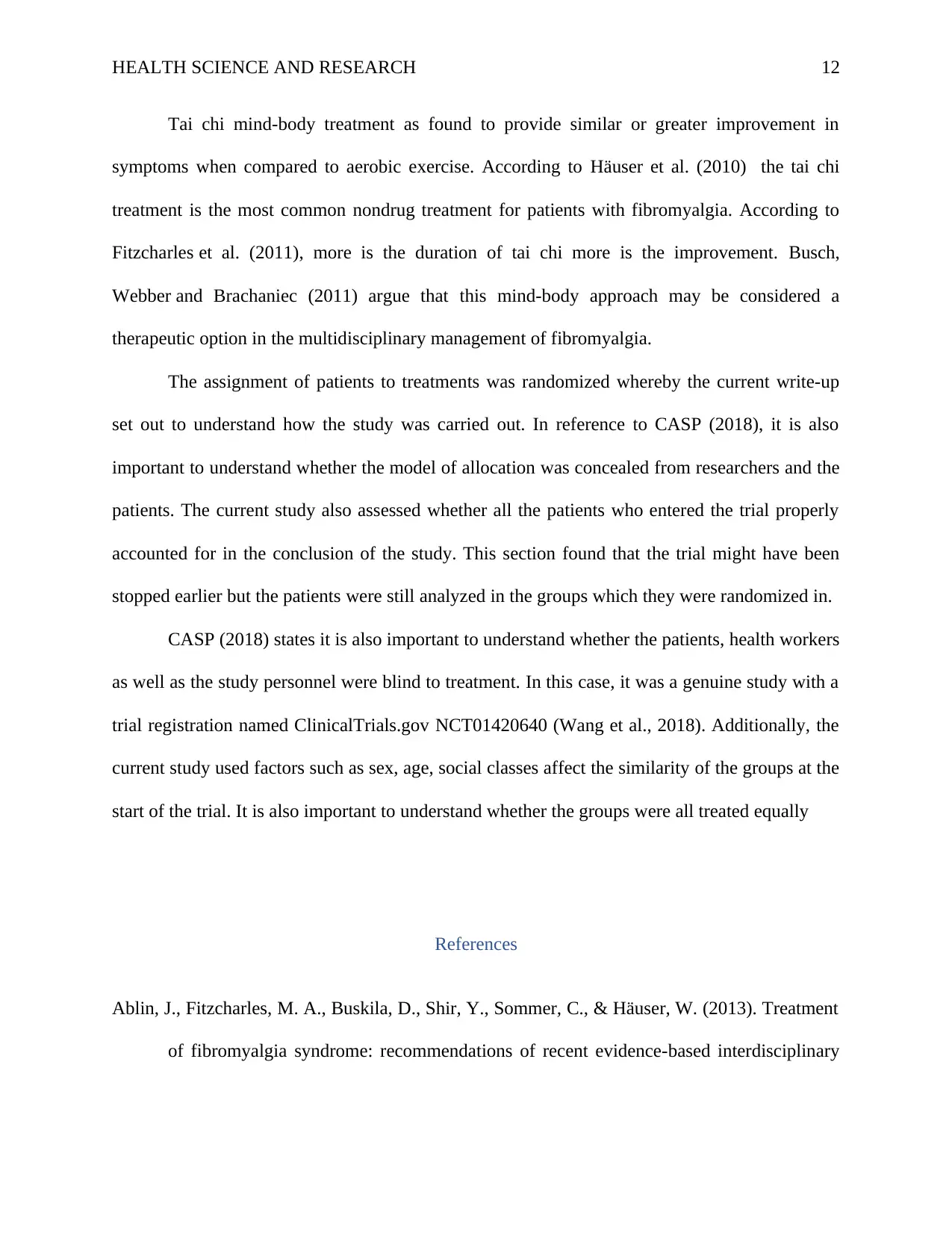
HEALTH SCIENCE AND RESEARCH 12
Tai chi mind-body treatment as found to provide similar or greater improvement in
symptoms when compared to aerobic exercise. According to Häuser et al. (2010) the tai chi
treatment is the most common nondrug treatment for patients with fibromyalgia. According to
Fitzcharles et al. (2011), more is the duration of tai chi more is the improvement. Busch,
Webber and Brachaniec (2011) argue that this mind-body approach may be considered a
therapeutic option in the multidisciplinary management of fibromyalgia.
The assignment of patients to treatments was randomized whereby the current write-up
set out to understand how the study was carried out. In reference to CASP (2018), it is also
important to understand whether the model of allocation was concealed from researchers and the
patients. The current study also assessed whether all the patients who entered the trial properly
accounted for in the conclusion of the study. This section found that the trial might have been
stopped earlier but the patients were still analyzed in the groups which they were randomized in.
CASP (2018) states it is also important to understand whether the patients, health workers
as well as the study personnel were blind to treatment. In this case, it was a genuine study with a
trial registration named ClinicalTrials.gov NCT01420640 (Wang et al., 2018). Additionally, the
current study used factors such as sex, age, social classes affect the similarity of the groups at the
start of the trial. It is also important to understand whether the groups were all treated equally
References
Ablin, J., Fitzcharles, M. A., Buskila, D., Shir, Y., Sommer, C., & Häuser, W. (2013). Treatment
of fibromyalgia syndrome: recommendations of recent evidence-based interdisciplinary
Tai chi mind-body treatment as found to provide similar or greater improvement in
symptoms when compared to aerobic exercise. According to Häuser et al. (2010) the tai chi
treatment is the most common nondrug treatment for patients with fibromyalgia. According to
Fitzcharles et al. (2011), more is the duration of tai chi more is the improvement. Busch,
Webber and Brachaniec (2011) argue that this mind-body approach may be considered a
therapeutic option in the multidisciplinary management of fibromyalgia.
The assignment of patients to treatments was randomized whereby the current write-up
set out to understand how the study was carried out. In reference to CASP (2018), it is also
important to understand whether the model of allocation was concealed from researchers and the
patients. The current study also assessed whether all the patients who entered the trial properly
accounted for in the conclusion of the study. This section found that the trial might have been
stopped earlier but the patients were still analyzed in the groups which they were randomized in.
CASP (2018) states it is also important to understand whether the patients, health workers
as well as the study personnel were blind to treatment. In this case, it was a genuine study with a
trial registration named ClinicalTrials.gov NCT01420640 (Wang et al., 2018). Additionally, the
current study used factors such as sex, age, social classes affect the similarity of the groups at the
start of the trial. It is also important to understand whether the groups were all treated equally
References
Ablin, J., Fitzcharles, M. A., Buskila, D., Shir, Y., Sommer, C., & Häuser, W. (2013). Treatment
of fibromyalgia syndrome: recommendations of recent evidence-based interdisciplinary
⊘ This is a preview!⊘
Do you want full access?
Subscribe today to unlock all pages.

Trusted by 1+ million students worldwide
1 out of 16
Related Documents
Your All-in-One AI-Powered Toolkit for Academic Success.
+13062052269
info@desklib.com
Available 24*7 on WhatsApp / Email
![[object Object]](/_next/static/media/star-bottom.7253800d.svg)
Unlock your academic potential
Copyright © 2020–2025 A2Z Services. All Rights Reserved. Developed and managed by ZUCOL.





